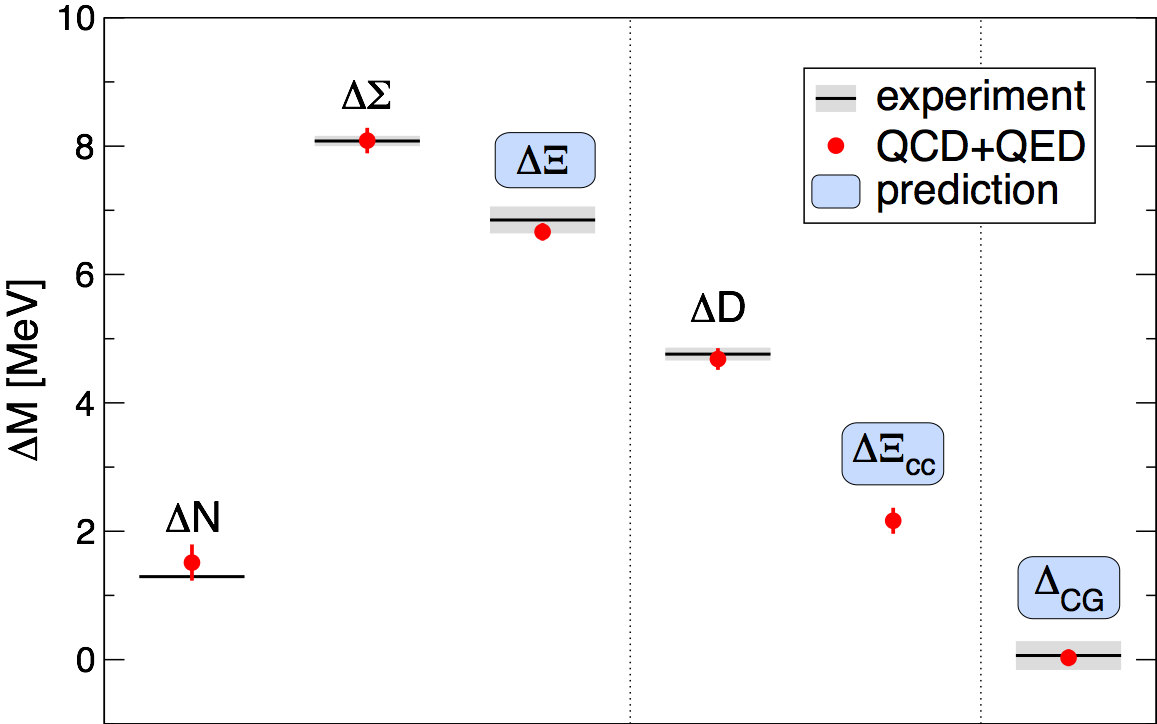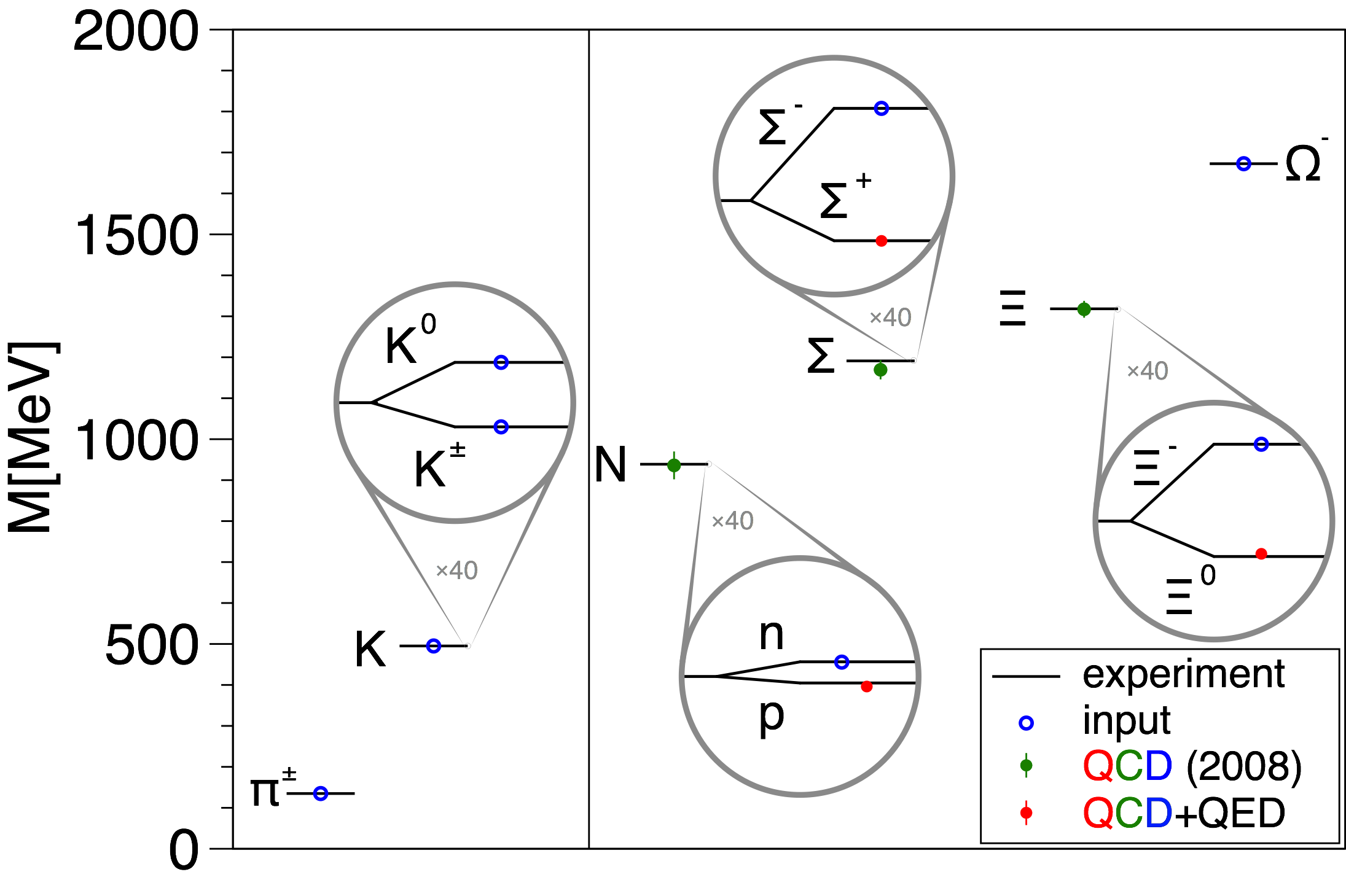Why is the neutron heavier than the proton?
The fact that the neutron is slightly more massive than the proton is essential for understanding how atomic nuclei form in the early universe, as well as for understanding many of their properties observed today. Using supercomputers among the most powerful in the world, a team of physicists mainly from France, Germany and Hungary, calculated the minute difference in mass between neutrons and protons and confirmed that this difference results from a partial cancellation between quark mass and electromagnetic effects.
Although they differ in their electrical charge, the neutron, neutral as its name suggests, and the proton, with positive charge, are almost identical twins. These two particles, that make up atomic nuclei, share many physical properties. In particular, their masses are nearly identical, with the neutron only a tenth and a half of a percent more massive than the proton. This slight difference is critical, both to ensure the stability of chemical elements and to determine the relative abundance of these elements in the universe. It results from a partial cancellation between two opposite effects. On the one hand, the mass associated with the energy of the electric field created by the proton increases its mass compared to that of the neutron. On the other, the quarks that make up the neutron are on average heavier than those that make up the proton. The end result then depends on the relative importance of these two effects, which had never been calculated reliably using the standard model of particle physics. Recently, such a calculation was performed by a team of theoretical physicists mainly from the Centre de Physique Théorique (CNRS / Aix-Marseille University / University of Toulon), the University of Wuppertal, the Forschungzenrum Jülich and Eötvös University Budapest. They used some of the most powerful supercomputers in the world, at the Forschungszentrum Jülich and at the Institut du développement et des ressources en informatique scientifique - IDRIS (CNRS), whose computers are funded by GENCI. Their calculation quantitatively confirms that quark-mass effects prevail over electromagnetic effects in this case. The team also studied these effects on the masses of other particles made of quarks, and made three predictions that have yet to be verified by experiment with a commensurate accuracy. This work is published in the journal Science.
A conceptual, algorithmic and technological challenge
In 2008, this same international collaboration had numerically calculated the average mass of the proton and the neutron. That work confirmed that this mass is mainly due to the kinetic and interaction energy between the quarks that make up protons and neutrons, while the mass of the quark constituents contribute at most on the order of one percent of the total. This result was obtained using numerical simulations in quantum chromodynamics (QCD), the component of the Standard Model that describes the strong interaction. However, with an accuracy of 4%, this work could not be used to determine the origin of the mass difference between the proton and the neutron, which is 30 times smaller than these 4%. The challenge faced by the scientists was therefore significant and required major conceptual, algorithmic, and technological advances.
First, from a theoretical point of view, the physicists had to account for the mass associated with the energy of the electric field of the proton. Therefore they had to include quantum electrodynamics in their calculations, which had been neglected in 2008. This required understanding how to formulate this theory in a finite spacetime, such as those used in the numerical simulations, how to control the large distortions induced by the finite size of the spacetime, how to fix the theory's parameters, and how to simulate efficiently this new interaction. They also had to independently treat the up and down quarks. From a numerical point of view, they had to implement new algorithms to work in spacetime volumes up to 16 times larger and with a statistical sample about 1000 times larger than in their calculation of 2008. The scientists also had to develop new methods to analyze the raw simulation results. Finally, the physicists were fortunate to be given access to a new generation of supercomputers capable of millions of billions of operations per second.
One last trick enabled the scientists to achieve this result. By focusing on what differentiates proton and neutron, rather than on what they have in common, they were able to calculate the mass difference with an uncertainty of only 20%. This would correspond to an accuracy on each of the two masses taken individually which is 150 times more precise than that reached in 2008.
In the longer term this work opens the door to a new generation of calculations of quark and hadron properties that is potentially ten times more accurate than today’s state-of-the-art calculations, whose precision is of the order of a percent. Such improvements are needed to continue to test the standard model of particle physics, and perhaps help uncover new fundamental physics in increasingly precise experiments involving quarks within hadrons.

Figure 1 : Mass differences between two members of various pairs of hadrons, here particles made of quarks and / or antiquarks. In the absence of the electromagnetic interaction and for up and down quarks of equal mass, these differences would vanish. The fact that they do not is a consequence of these effects. The red dots represent the results of the calculations with their error bars. The black horizontal lines, surrounded by gray bands are the experimental measurements and their uncertainties. Labels surrounded by blue represent predictions that have yet to be verified with a similar accuracy by experiment. The neutron-proton mass difference is denoted ΔN and is displayed at the left of the figure. Units are mega-electron-volts (MeV). The mass of a hydrogen atom is approximately 1000 MeV.

Figure 2 : Comparison of 2008 results with a few of those obtained here for masses of light hadrons. The light hadrons shown here are particles composed of up, down and strange quarks and / or antiquarks. In 2008, only the average mass of a pair of hadrons in a same “isospin"multiplet could be calculated. These results, together with their uncertainties, correspond to the green dots and the black horizontal lines that cross these dots represent experimental measurements. To view the results of the new calculation one has to imagine watching the figure under a microscope that magnifies 40 times. One would then see that the black horizontal lines are divided into two new lines which indicate the experimental values of the masses of the two hadrons of a same pair. In the enlarged areas, the red dots correspond to the results of the calculations. The neutron and proton are indicated by n and p, respectively. Blue open dots indicate that the corresponding hadron masses were used to fix one of the six parameters of the fundamental theory employed in the new calculation, or to fix one of the two masses of a pair (here we only calculate mass differences). Units are mega-electron-volts (MeV). The mass of a hydrogen atom is approximately 1000 MeV.

Figure 3 : This figure shows how the neutron-proton mass difference depends on two combinations of fundamental parameters. On the horizontal axis, the fine structure constant, proportional to the square of the elementary unit of charge is varied from zero to twice its measured value. Along the vertical axis, it is the difference in mass between down and up quarks that is varied. The blue cross indicates the point corresponding to our universe. The black curves correspond to contours of constant neutron-proton mass difference. Each has a label indicating the value of the neutron-proton mass difference to which it corresponds. Any point in the blue region corresponds to a very different universe from ours, in which the proton could decay into a neutron through the weak interaction. Units are mega-electron-volts (MeV). The mass of a hydrogen atom is approximately 1000 MeV.
Further information
Ab initio
calculation of the neutron-proton mass difference
Sz. Borsanyi1, S. Durr1,2, Z. Fodor1,2,3,
C. Hoelbling1, S. D. Katz3,4, S. Krieg1,2,
L. Lellouch5, T. Lippert1,2, A.
Portelli5,6, K. K. Szabo1,2, B. C. Toth1
,
Science (27 March 2015)
- The paper is also available from the open access e-print service arXiv
Contact
Laurent Lellouch, Research Director in the CNRS
Links to institutional affiliations
1 Department of Physics,
University of Wuppertal, German
2 Jülich Supercomputing
Centre, Forschungszentrum Jülich, Germany
3 Institute for
Theoretical Physics, Eötvös University, Budapest, Hungary
4 MTA-ELTE Lendület
Lattice Gauge Theory Research Group, Budapest, Hungary
5 Centre de Physique Théorique - CPT
(CNRS / Aix-Marseille Université / Université de Toulon)
, France
6 School of Physics & Astronomy,
University of Southampton, UK
Contacts at the CNRS Institute of Physics
Jean-Michel Courty,
Catherine Dematteis,
Simon Jumel,
inp.com cnrs.fr